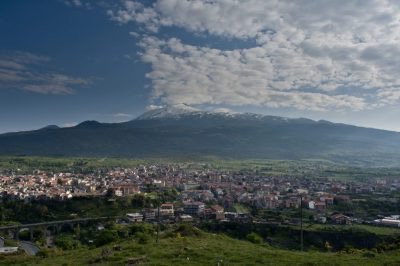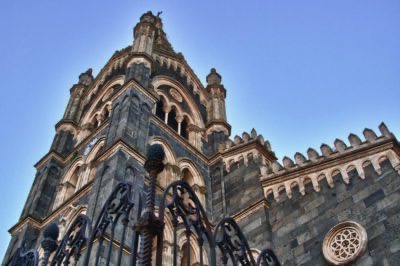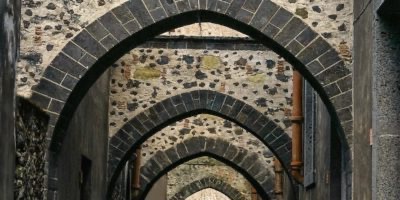A town rich in history where you can enjoy a magical medieval atmosphere: ready to stroll through the historic center?
Imagine yourself on a wonderful island surrounded by a crystalline sea, the sun that warms your skin, the air impregnated with pleasant smells, your eyes delighted with fascinating colors. Beautiful, is not it? Narrow your focus now, like you do on maps. You are now in a lovely location a 765 meters above sea level which lies serene at the foot of a majestic volcano, a place with medieval charm chock full of works of art. Do you have the scene in mind? No, it's not the beginning of a dream, if you're wondering: it's there Sicily!

Randazzo and medieval history
The town where I dragged you is Randazzo, a fantastic town with medieval history 40 minutes from the sea that supports the old, but still active, Mother Etna. City of ancient origins, it is surrounded by greenery and takes its breath from three large lungs: they are, in fact, the Etna park, Nebrodi Park and Alcantara River Park to surround it.
Visiting Randazzo means walking along narrow streets of ancient beauty that allow anyone who goes there to go back in time to immerse themselves in the clothes of the remote inhabitants of the Middle Ages. All this, of course, will only be possible once you arrive in heart of the town, in its beautiful Old Town.
The historic center of Randazzo
Corso Umberto I is the main street, a walking area often closed to traffic, here are concentrated numerous monumental, historical and cultural attractions of the country that I will present to you starting from the central square.
The pivot of the whole urban complex are the two large squares of Loreto square, where the War Memorial is located in honor of all the war dead during the world wars; Randazzo in fact received the silver medal for civil merit during the Second World War and was targeted by the devastating and numerous war bombings of that period.
The Basilica of Randazzo
Strolling along the lava stone carpet del Corso, we will find on our right the Mother Church of the country, the Basilica of Santa Maria Assunta. This Gothic-Norman style church is the main place of worship for the Randazzese. It consists mostly of lava stone and sees its birth in the early 1200s.

Raised on the steps of the square of the same name and protected by imposing gates, according to legend it was built in the place where a poor shepherd found a flame lit inside a cave and built a first wooden altar there.
The famous Civic Museum of Natural Sciences
Continuing our journey, always on the right, we will then visit the very interesting one Civic Museum of Natural Sciences "Angelo Priolo". This museum, of great scientific importance, consists of 6 rooms and houses a varied ornithological collection that houses about 2000 specimens of 400 different species including birds of Italian avifauna, extinct specimens and exotic birds.
Not just birds: the museum is also home to insects and mammals. The part of the museum dedicated to geology is also interesting: the collection includes fossils, minerals, rocks and shells from Sicily. A place not to be missed!
A little further on, our gaze will be lost on a large clearing, that of Piazza Municipio, seat of the town hall. Former convent of the minor friars, the building houses a graceful municipal cloister with a square plan that sees a cistern at its center and a long sequence of arches and columns along its perimeter.
The most suggestive way
Immediately on the right of Piazza Municipio, we will find the most suggestive street in the town, the Via degli Archi, sought after by all tourists who come to discover this medieval village. Characterized by lava stone pebbles, pointed arches and wonderful mullioned windows.

Walking along it will take us to one of the oldest districts of Randazzo, that of San Nicola, where, in the homonymous square we will observe the Church of San Nicolò di Bari in Norman-Swabian style, but with an imposing facade with classical elements.
The bell tower and the interiors were rebuilt, the first after the earthquake of 1693 and the second after the bombings of 1943. Interesting is the statue placed in front of the entrance of the Church: this personages the giant Piracmone accompanied by an eagle, a lion and a serpent, symbols of the three original districts of the city (respectively Santa Maria, San Nicola and San Martino).
A very old square
Returning to Corso Umberto, we will then arrive at Piazza San Martino, square of the most beautiful district of Randazzo and the oldest. The Church of San Martino, located in the homonymous square, has a late Renaissance facade and is flanked by what has been defined as the most beautiful bell tower in Sicily. Dating back to 1200, it is made up of four superimposed dice which see splendid mullioned and triple mullioned windows.
A few steps from Piazza San Martino, is located the Civic Archaeological Museum Paolo Vagliasindi. Inside this castle, a former prison, there is a notable archaeological collection. The museum is set up by 6 rooms that include two prehistoric and Greek Pithoi, an Oinochoe (red-figure vase with the myth of the Harpies), balsam bottles in the shape of animals, numerous ceramics related to everyday life, vases decorated with motifs of daily life and mythology , black pottery and statuettes.
Not much further on, finally, there is one of the gates of the city walls still intact, the Gate of San Martino. In fact, in the past, the whole historic center of Randazzo was fortified and surrounded by mighty walls in lava stone that continued for about 3 kilometers. Along the walls there were 12 gates, of which unfortunately only 4 remain today.
Other attractions to visit outside the historic center
Monastery of San Giorgio: former convent of the Benedictine nuns, a place of legends, but not accessible to the public.
Aragonese gate: in the district of San Giorgio. Restored by King Pietro d'Aragona in 1282, it houses the coats of arms of the King and his wife Costanza next to that of Randazzo.
Gate of San Giuseppe: preceded by a graceful staircase.
Porta Pugliese: dating back to the XNUMXth century, it overlooks the Alcantara and the remains of the new bridge.
Saint Peter Square: place that offers a spectacular view of Etna.
Staircase of the Capuchins: evocative staircase leading to the church of the same name from the lava stone portal.
Demanio Sciarone Park: lung of the city, wonderful equipped park in the Etna Park.
Gurrida lake: the only wet area of the Etna Park fed by the Flascio river.
Course of the Alcantara river: river of the rich natural heritage of the Alcantara Valley.
Etna: the largest volcano in Europe on which to carry out magnificent hiking activities.


























